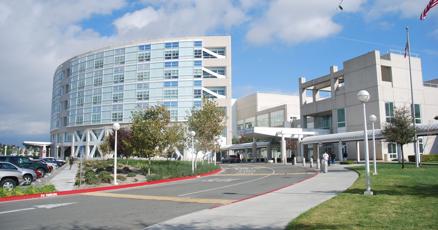Buildings/Structures Analyzed and Designed using 3D-BASIS suite of programs
Satish Nagarajaiah is the Original and Primary Developer of 3D-BASIS Computer Program for Nonlinear Dynamic Analysis of Three Dimensional 3D Seismic Base Isolated Structures in 1989, which he did as a part of his doctoral research from 1987 to 1990 (working with Andrei Reinhorn). Since then Satish Nagarajaiah, Andrei Reinhorn and Michael Constantinou have collaborated in enhancing it into a series of programs.
The 3D-BASIS program series originally developed by Satish Nagarajaiah has the capability to analyze buildings and bridge systems with complex isolation systems. The program was structured to adapt and easily add new models of isolation systems without modifying the original pseudo force solution algorithm, semi-implicit algorithm, numerical and analytical procedures originally developed by Satish Nagarajaiah.
The development of 3D-BASIS program facilitated the expanding use of the base isolation in the United States as per James Kelly, and others, in their books on Seismic Isolation, more recently as in the paper EESD 2018 Makris – Seismic isolation – Early History which also states that the models and 3D-BASIS computer programs served as the basis for those in commercial software SAP2000 used now a days in the analysis of seismically isolated structures.
“The most widely used computer program for analyzing base isolated structures today is the 3D-BASIS suite of programs…” quote from…
- Earthquake Resistant Design with Rubber by James M. Kelly, 1997, 2nd Edition, Springer Verlag, London (Page 234)
- Design of Seismic Isolated Structures: From Theory to Practice by Farzad Naeim and James M. Kelly, 1999, 1st Edition, John Wiley, New York (Page 217).
Referred to by current national building codes..
- NEHRP Guidelines for the seismic rehabilitation of buildings, Federal Emergency Management Agency, FEMA 273/274, ATC 33 (Page 9-9,9-46), FEMA-356 (2000)
- NIST GCR 10-917-5 (2010) NEHRP Seismic Design Technical Brief No. 4 “Nonlinear Structural Analysis For Seismic Design A Guide for Practicing Engineers,” by Gregory G. Deierlein, Andrei M. Reinhorn and Michael R. Willford.
3D-BASIS suite of computer programs have had significant impact on the analysis and design of large base isolated buildings and bridges all over the world. Following are a few examples where a team of collaborators have implemented 3D-BASIS in analysis, design and retrofit of buildings-bridges or new base isolated buildings or bridges.
US Court of Appeals Building – San Francisco
The 100-year-old Court of Appeals Building in San Francisco, California was retrofitted after the 1989 Loma Prieta earthquake using seismic isolation – friction pendulum bearings – and was fully reoccupied in 1996. Sensors placed below and above the isolators allow measurement of the effectiveness of the system. 3D-BASIS program was used for the analysis and validation. The analysis and design was performed by Skidmore Owings and Merrill, CA, USA.
1996 ASCE JSE Mokha et al Seimsic Isolaiton Retrofit of Large Historic Building

San Francisco International Airport Terminal
San Francisco’s International Airport Terminal is supported 267 seismic isolation – friction pendulum bearings . This landmark building is protected from a major earthquakes in California primarily due to seismic isolation. 3D-BASIS suite of programs were used for the analysis and validation along with ETABS and SAP programs. The analysis and design was performed by Skidmore Owings and Merrill, CA, USA.
AISC_Modern Steel Construction 1999_v10_Wings of Isolation_Mokha and Lee
Details in a TAMU Architecture Student Presentation

Los Angeles City Hall
Los Angeles City Hall building is retrofitted with four hundred and sixteen high damping rubber bearings, 90 flat sliding bearings and 64 viscous dampers have been installed as part of the seismic rehabilitation. The building is a 460 feet tall steel frame with unreinforced masonry infill. The rehabilitation consists of installing high damping rubber bearings at its base supplemented with nonlinear viscous dampers. The analysis and design was performed by Nabih Youssef and Associates, AC Martin Partners, Inc. and University of California Los Angeles, CA, USA
2000 The Structural Design of Tall Buildings – Youssef et al- Los Angeles City Hall
The Los Angeles City Hall
Arrowhead Regional Medical Center, Colton, CA
The Arrowhead Regional Medical Center, located in Colton, CA, consists of six separate building structures containing a total of approximately 920 000 square foot of floor space for hospital and support services. Five of the six buildings are base-isolated. Each of the five base-isolated buildings is of different size and configuration, ranging from a six-storey, 360000-square-foot curved-front nursing tower to a two-storey, 24000-square-foot rectangular shaped central plant building. The building structures are framed with structural steel, utilizing concentric braced frames as the lateral force resisting system. The base-isolation system is a hybrid passive energy dissipation system consisting of both linear and nonlinear and high damping rubber bearings along with viscous damping devices located at the base of the structure. The high damping rubber bearings provide both lateral stiffness, which governs the fundamental period of vibration of the system and hysteretic damping, while the viscous damping devices provide velocity- dependent damping, which serves to control overall building displacements. 3D-BASIS suite of programs were used for the analysis and validation along with ETABS and SAP programs by KPFF Consulting Engineers, CA, USA.

The Arrowhead Regional Medical Center, Colton, CA
The use of 3D-BASIS program in practical applications in real projects are noteworthy (as highlighted in MCEER Research Accomplishments 1987_1994 (3D-BASIS implementation):
(1) Retrofit of the U.S.Court of Appeals in San Francisco, California , a historical building about 100 years old of 350,000 sq. ft., previously damaged in 1906 San Francisco and in 1989 Loma Prieta earthquakes, was retrofitted with more than 250 pendulum friction sliding bearings.
(2) Construction of Emergency Response Building (911) in Los Angeles, California. A building of 30,000 sq. ft. was designed and constructed using 28 elastomeric bearings.
(3) New Los Angeles County Martin Luther King Hospital, Charles R. Drew Trauma Center, a 200,000 sq. ft. building was constructed using 70 high damping rubber bearings and 12 sliders. The design was verified using 3D-BASIS by the regulatory government agency.
(4) San Bernadino County Medical Replacement Facility, a complex of 840,000 sq.ft. was designed with 400 elastomeric bearings and 1233 viscous fluid damping devices.
(5) Los Angeles County/University of Southern California hospital, a $250 million dollar base isolated facility.
(6) Retrofit of Los Angeles City Hall using elastomeric bearings and supplementary damping devices.
(7) Retrofit of San Francisco City Hall using elastomeric bearings and complementary damping devices.
(6) LNG tanks in Greece with sliding isolation system.
3D-BASIS Suite of programs have been used in many other projects by leading researchers, engineers and practitioners. Here are some real projects with cited references.
- The 100-year-old Court of Appeals Building in San Francisco, California was retrofitted after the 1989 Loma Prieta earthquake using seismic isolation – friction pendulum bearings – and was fully reoccupied in 1996. Sensors placed below and above the isolators allow measurement of the effectiveness of the system. 3D-BASIS program was used for the analysis and validation. The analysis and design was performed by Skidmore Owings and Merrill, CA, USA. 1996 ASCE JSE Mokha et al Seimsic Isolaiton Retrofit of Large Historic Building
- San Francisco’s International Airport Terminal is supported 267 seismic isolation – friction pendulum bearings . This landmark building is protected from a major earthquakes in California primarily due to seismic isolation. 3D-BASIS suite of programs were used for the analysis and validation along with ETABS and SAP programs. The analysis and design was performed by Skidmore Owings and Merrill, CA, USA. AISC_Modern Steel Construction 1999_v10_Wings of Isolation_Mokha and Lee
- 3D-BASIS was used for analysis of Benicia-Martinez Bridge that spans the Carquinez Straits connecting the cities of Benicia and Martinez on Interstate Highway 680 between the counties of Solano and Contra Costa in California by S. C. Solutions Inc., CA, USA and Parsons Brinckerhoff Quade and Douglas Inc, CA, US as presented in the journal paper 1999 Comp Struc Benetia Martinez Bridge FPS 3DBASIS
- Los Angeles City Hall building is retrofitted with four hundred and sixteen high damping rubber bearings, 90 flat sliding bearings and 64 viscous dampers have been installed as part of the seismic rehabilitation. The building is a 460 feet tall steel frame with unreinforced masonry infill. The rehabilitation consists of installing high damping rubber bearings at its base supplemented with nonlinear viscous dampers. The analysis and design was performed by Nabih Youssef and Associates, AC Martin Partners, Inc. and University of California Los Angeles Researchers, CA USA. 3D-BASIS was used for the analysis and design. 2000 The Structural Design of Tall Buildings – Youssef et al- Los Angeles City Hall
- The Arrowhead Regional Medical Center, located in Colton, CA, consists of six separate building structures containing a total of approximately 920 000 square foot of floor space for hospital and support services. 3D-BASIS suite of programs were used for the analysis and validation along with ETABS and SAP programs by KPFF Consulting Engineers . 2001 The Structural Design of Tall Buildings Asher et al. SEISMIC ISOLATION DESIGN OF THE ARROWHEAD REGIONAL MEDICAL CENTER
- Use of 3D-BASIS in Seismic retrofit of Ataturk International Airport Terminal Building as presented in the MCEER Research Progress and Accomplishments 2000-2001. 3D-BASIS suite of programs were used for the analysis and validation along with IDARC by SUNY – Buffalo and LZA Technology, Thornton- Tomasetti Group, New York, NY, USA and Turkey Engineers. MCEER-01-Sp01-Seismic Retrofit of Ataturk International Airport Terminal Building
- 11WCEE Jim Kelly_1996_Low Cost Housing base isolation– 3D-BASIS was used for the construction of a four-story reinforced concrete building, supported on high-damping natural rubber (HDNR) isolators, in the south of Java, Indonesia by University of California, Berkeley, USA. The construction of this demonstration building was sponsored by the United Nations Industrial Development Organization (UNIDO) to introduce base-isolation technology to developing countries.
- Use of 3D-BASIS in six-story seismic-isolated hospital building located in south central Los Angeles on an alluvium site which is only two miles away from the Newport-Inglewood fault by John A. Martin and Associates Inc. and Law/Crandall Inc. CA, USA (Earthquake Spectra Journal 1995 Naeim-Lew On-the-use-of-design-spectrum-compatible-time-histories).
- Many more structures have been analyzed and designed using 3D-BASIS suite of programs. These include airport building complexes, hospital buildings, other buildings, major bridges, offshore platforms and tanks in USA, Turkey, Canada, China, England, Germany, Greece, Italy, Japan, New Zealand, Indonesia, India, and many other countries.
- Latest being the Apple headquarter friction pendulum isolated building in CA completed in 2018.
